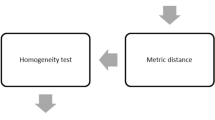Abstract
Regional frequency approaches are frequently proposed in order to estimate runoff quantiles for non-gauged catchments. Partitioning methods such as cluster analysis are often applied in order to regionalize catchments using topography, soil and hydroclimatological characteristics. This paper aims to construct a mean regional frequency curve for annual maximum runoffs, using topographic descriptors for cluster analysis. Both trellis and hierarchical classifications partitioning methods are performed using basin area; basin perimeter; characteristic length; global slope index; compaction index; specific gradient slope and geodesic coordinates as attributes. To build the distance measures, various multidimensional spaces are considered with pairs or triplets of attributes. Resulting clusters were checked for hydrological homogeneity using the test of Hosking and Wallis based on L-moments estimates. A sample of 40 Tunisian gauged basins covering a range of areas from 56 to 16483 km2 has been considered to achieve these purposes. The classification and the test of Hosking and Wallis concluded for separating the gauged basins in two hydrological homogeneous regions. Also, the basin global slope index is found as the main discriminating classification factor. Further, regional quantiles of the standardized maximum annual flood (index flood) were estimated using GEV distribution. The two regional curves are distinguishable for extremes events, suggesting that the second region with high slope index displays more variability in the extremes. However, comparisons of RMSE results using two regions against one single pooled region suggest that estimation of standardized quantiles is more accurate in the case of one single region for non extreme events.







Similar content being viewed by others
References
Alila Y (1999) A hierarchical approach for the regionalization of precipitation annual maxima in Canada. J Geophys Res 104(D24-31):645–655
Bargaoui ZK, Fortin V, Bobée B, Duckstein L (1998) Une approche floue pour la détermination de la région d'influence d'une station hydrométrique. Rev Sci Eau 11(2):255–282. doi:10.7202/705307ar
Burn DH (1990) Evaluation of regional flood frequency analysis with a region of influence approach. Water Resour Res 26(10):2257–2265. doi:10.1029/WR026i010p02257
Burn DH, Goel NK (2000) The formation of groups for regional flood frequency analysis. Hydrol Sci J 45(1):97–112. doi:10.1080/02626660009492308
Castellarin A, Burn DH, Brath A (2001) Assessing the effectiveness of hydrological similarity measures for flood frequency analysis. J Hydrol 241:270–285. doi:10.1016/S0022-1694(00)00383-8
Castellarin A, Burn DH, Brath A (2008) Homogeneity testing: How homogeneous do heterogeneous cross-correlated regions seem? J Hydrol 360:67–76
Celeux G, Diday E, Govaert G, Lechevallier Y, Ralambondrainy H (1989) Classification automatique des données. Dunod, Paris
Chow VT (1964) Handbook of applied hydrology. McGraw Hill, New York
Coles S (2001) An introduction to statistical modelling of extreme values. Springer, London
Dalrymple T (1960) Flood-frequency analyses. US Geological Survey Water-Supply Paper1543-A.
Ministère de l’Agriculture et des Ressources hydrauliques et de la Pèche, DGRE (2005) www.semide.tn/collect/annuaire
Durbin J, Knott M (1971) Components of cramér – von MisesStatistics. London school of economy and political. Science, UK
Fill HD, Stedinger JR (1995) Homogeneity tests based upon gumbel distribution and a critical appraisal of Dalrymple’s test. J Hydrol 166(1–2):81–105
Gaume E, Gàal L, Viglione A, Szolgay J, Kohnovà S, Bloschel G (2010) Bayesian MCMC approach to regional flood frequency analyses involving extraordinary flood events at ungauged sites. J Hydrol 394:101–117. doi:10.1016/j.jhydrol.2010.01.008
Hosking JRM, Wallis JR (1993) Some useful statistics in regional frequency analysis. Water Resour Res 29(2):271–281. doi:10.1029/92WR01980
Jambu M (1989) Exploration informatique et statistique des données. Dunod, Paris
Jedidi K, Bargaoui Z, Benzarti Z (2009) Identification des zones pluviométriques homogènes en bassin versant basée sur l’information topographique. Rev Sci Eau 22(3):383–395. doi:10.7202/037777ar
Kasner James H, Marcellin Michael W (1999) Universal trellis coded quantization. IEEE Trans Image Process 12:1667–1687
Lu LH (1991) Statistical Methods for Regional Flood Frequency Investigations. Dissertation, Cornell University Ithaca NY
Lu L, Stedinger JR (1992) Sampling variance of normalized GEV/PWM quantile estimators and a regional homogeneity test. J Hydrol 138:223–245. doi:10.1016/0022-1694(92)90166-S
Ouarda T, Girard C, Cavadias GS, Bobée B (2001) Regional flood frequency estimation with canonical correlation analysis. J Hydrol 254(1–4):157–173
Pandey GR, Nguyen VTV (1999) A comparative study of regression based methods in regional flood frequency analysis. J Hydrol 225:92–101
Saporta G (1990) Probabilités. Analyses des données et statistiques. Technip, Paris
Scholz FW, Stephens MA (1987) K-sample Anderson–darling tests. J Am Stat Assoc 82:918–924
Singh VP (1992) Elementary hydrology. Prentice-Hall, Englewood Cliffs
Tsakiris G, Nalbantis I, Cavadias G (2011) Regionalization of low flows based on canonical correlation analysis. Adv Water Resour 34(7):865–872. doi:10.1016/j.advwatres.2011.04.007
Viglione A, Laio F, Claps P (2007) A comparison of homogeneity tests for regional frequency analysis. Water Resour Res 43. doi:10.1029/2006WR005095
Wallis JR, Schaefer MG, Barker BL, Taylor GH (2007) Regional precipitation frequency analysis and spatial mapping for 24-hour and 2-hour durations for Washington state. Hydrol Earth Syst Sci 11(1):415–442. doi:10.5194/hess-11-415-2007
Yadav M, Wagener T, Gupta H (2007) Regionalization of constraints on expected watershed response behaviour for improved predictions in ungauged basins. Adv Water Resour 30:1756–1774
Zrinji Z, Burn DH (1994) Flood frequency analysis for ungauged sites using a region of influence approach. J Hydrol 153(1–21):3
Acknowledgments
Authors would like to thank the water resources division of the Tunisian Agricultural Ministry (W.R.D.) for the Database. We also sincerely, thank the anonymous reviewer and the editor for their constructive comments and suggestions which helped improving our initial manuscript.
Author information
Authors and Affiliations
Corresponding author
Rights and permissions
About this article
Cite this article
Chérif, R., Bargaoui, Z. Regionalisation of Maximum Annual Runoff Using Hierarchical and Trellis Methods with Topographic Information. Water Resour Manage 27, 2947–2963 (2013). https://doi.org/10.1007/s11269-013-0325-0
Received:
Accepted:
Published:
Issue Date:
DOI: https://doi.org/10.1007/s11269-013-0325-0




